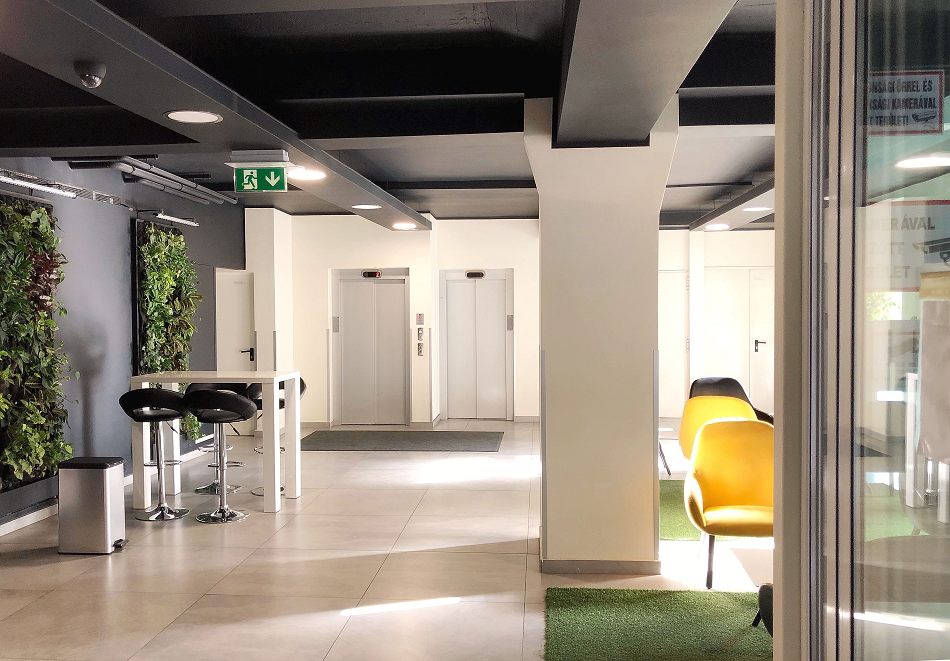The term ‘fit out’ is used to describe the process of making an interior space suitable for occupation. It consists of a range of services including interior walls, plastering, flooring, electrical, decoration, lighting, mechanical installations, furnishings and/or any other improvements made to the interior of premises.
It is mainly used in relation to the fit-out of commercial developments, where the main construction is completed by the developer and the final fit-out by the tenant/occupier. A fit-out is said to be complete once it is ready to be occupied and used.
A typical office fit-out princess takes a space through three key stages which will then end in occupancy:
- Shell and core
- Cat-A Fit-Out
- Cat-B Fit-Out
What Is A Shell and Core Office Fit-Out?
A shell and core fit-out is the first stage of a building fit-out and refers to the installation of the basic structure which then creates the ‘shell’.
The landlord or owner of the building provides the shell, which can sometimes be fitted out to a Cat A fit-out standard (more about Cat A fit-outs below). This varies between different developers, a typical shell and core fit-out includes:
- Loading bays
- Car parking
- Structure
- Cladding
- Receptions
- Base Plant
- Communal areas
- Lobbies
- Stairwells
- Lift shafts
- Basements
- Toilets
- External works
What Is A Cat A Office Fit-Out?
A Cat A fit our brings a space up to a standard where it is ready for occupation by the tenant. It usually involves just the basics. However, there is no standard definition of a Cat A fit-out and it can vary from developer to developer. It is worth establishing what the fit-out will entail when discussing this.
What Does A Cat A Office Fit Out Involve?
- Raised access floors and suspended ceilings
- Mechanical services such as air conditioning, ventilation, controls, etc.
- Electrical services – power, security/access architecture, basic luminaries, emergency lighting
- Fire detection and protection services that meet required building regs i.e. smoke detectors, sprinklers, hydrants and hoses, fire alarms
- Internal surface finishes
What is a Cat A Plus Office Fit Out?
A Cat A Plus fit-out is something between a Cat A fit-out and a Cat B fit-out. It essentially allows the tenant to move in with their staff, IT equipment and obligatory company dog.
What Does A Cat A Plus Office Fit-Out Involve?
- Fitted kitchens
- Partitioning includes meeting rooms, offices and breakout spaces
- Furniture and workspaces
- Re-routing air conditioning and power points
- IT installation and infrastructure
What is a Cat-B Office Fit-Out?
A Cat B fit-out where you get to make the new office space your own. It is often left to the tenant to design and install as it allows them to create something which fits their needs and requirements.
The work that goes into changing a blank Cat A fit-out into a fully functioning and operational Cat B space is the most important part of an office fit-out. It creates the environment that your team will spend their time in and needs to deliver the right mix of workstations, meeting rooms and breakout areas.
A proper Cat B Fit-out needs to consider how your team operates and works to ensure your offices are fit for your team for years to come. A tailored Cat-B fit-out should also reflect your brand, which will include custom design elements that showcase your brand to your team, clients and all that come into your space.
What Does A Cat B Office Fit-Out Involve?
- Design and brand detailing
- Speedlanes, turnstiles, bespoke doors
- Fitting-out reception areas
- New / enhanced luminaries
- IT installation and infrastructure
- Fully-fitted kitchens and non-communal office amenities
- Access control systems
- Wayfinding technology
- Installation of offices
- Commercial security systems
- Partitioning; including meeting rooms, offices and breakout spaces
- Sensor technology
- Fire extinguishers
- Business intruder alarm systems
- Installation of ICT equipment
- Commercial CCTV systems
- Furnishings
What Is The Difference Between A Cat A Office Fit-Out And A Cat B Office Fit-Out?
A Cat A fit-out is a space that is ready for occupation by a tenant, without furniture and fittings etc. A Cat B fit-out results in a bespoke space for the tenant with custom features and branding to create a warm and welcoming space for everyone.
What is the difference between an office fit-out and an office refurbishment?
A fit-out is carried out on new office space and an office refurbishment involves refurbishing your existing office space.
Office Fit-out Guide and Checklist
Step 1: Choose your project team
You need a team involved who will have great attention to detail and ensure that the end product is something that will fit your company in the years to come. The team also needs to be great negotiators and have the ability to communicate to all levels to ensure suppliers and tradespeople know what they need to do.
Step 2: Research & Planning
What does your team need and what do they want from a workspace? What are your limitations when it comes to the budget? What is the long-term strategy for the office? You need to think about your workspace, flow of people, goals and needs.
Step 3: Building search and survey
If your current space is not fit for purpose then you may need to appoint a commercial property agent to help find you a new office and help you secure it on the right terms.
Step 4: Choose your fit out specialist
Ensuring that you find a fit-out specialist who will help you evaluate your options based on your budget and requirements is key. You want to be able to get a finished solution that meets your exacting needs. We suggest that you speak to at least 3 fit out companies to allow you to compare each companies offerings and ideas.
Step 5: Design development and approvals
This is where your new workspace begins to take shape. You will be considering everything from materials, colour schemes and layouts. Having a close relationship and clear communication with your interior designer from your fit-out company is key to designing something which will suit your companies vision.
Step 6: The build and furniture installation
Although you may have planned everything perfectly, you cannot switch it off yet. Keep asking questions and make suggestions as the fit-out takes shape.
Step 7: Dilapidations
When moving offices you also need to consider your old space. Most contracts feature commercial dilapidations clauses that demand you leave your old office space as you found it. Make sure you have this in hand or it could cost you a lot of money.
Step 8: The big move
Ensure that you find the best removal company you can find, use recommendations from trusted partners. Ensure that people know how to get into your new office, where they can park and ensure staff orientation takes place to welcome your team.
Step 9: Relocation or refurbishment review
Every move always throws up the odd spanner in the works. Get your project team together to conduct a review and ensure these are quickly rectified.





